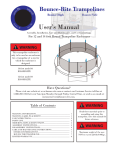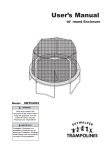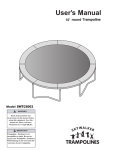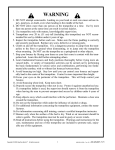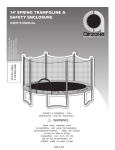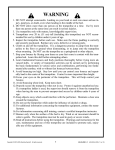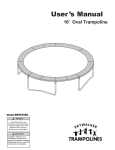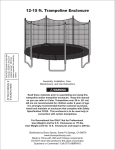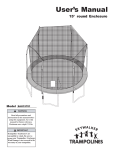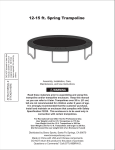Download User`s manual for BR Trampoline page FC
Transcript
Bounce Safe Bounce High u eH Sa Bo nc Bounce-Rite Trampolines fe lines po Bounc e ite Tram -R ig h B o u n ce User’s Manual Assembly, Installation, Care and Maintenance, and Use Instructions For 12 and 14 foot Round Trampolines (Sew this end up and to outside seem of trampoline) ! WARNING Do not attempt or allow somersaults (flips). Landing on head or neck can cause serious injury, paralysis, or death, even when landing in the middle of the trampoline mat (bed). Do not allow more than one person at a time on the trampoline. Use by more than one person at the same time increases the chance of injury. Use trampoline only with mature, knowledgeable supervision. © 2009 Essessco, Inc. All rights reserved. 14 foot model #: ESS-BB14TR 12 foot model #: ESS-BB12TR © 2009 Essessco, Inc. All rights reserved. Use trampoline only with mature, knowledgeable supervision. Do not allow more than one person at a time on the trampoline. Use by more than one person at the same time increases the chance of injury. Do not attempt or allow somersaults (flips). Landing on head or neck can cause serious injury, paralysis, or death, even when landing in the middle of the trampoline mat (bed). ! WARNING (Sew this end up and to outside seem of trampoline) Have Questions? Please visit our website at www.bounce-rite.com or contact our Customer Service toll-free at 1-888-260-5766 between 9am-5pm Monday through Friday, Central Time, or send us an email at: [email protected]. Table of Contents GENERAL SAFETY PRECAUTIONS.................................................... 1 WARNING INFORMATION................................................................... 2 WARNING LABEL PLACEMENT.......................................................... 2 TRAMPOLINE SAFETY AND ACCIDENT PREVENTION................. 3 USE AND INSTRUCTIONAL MATERIAL............................................ 5 PARTS LIST............................................................................................ 9 ORDERING REPLACEMENT PARTS.................................................. 9 ASSEMBLY INSTRUCTIONS................................................................ 10 DISASSEMBLY INSTRUCTIONS.......................................................... 13 CARE AND MAINTENANCE INSTRUCTIONS.................................... 14 OTHER CONSIDERATIONS.............................................................. 14 MOVING THE TRAMPOLINE........................................................... 14 LIMITED WARRANTY.......................................................................... 15 ! WARNING Read these materials prior to assembling and using this trampoline. Save this manual for future reference. ! WARNING Maximum weight of the user NOT to exceed 220 lbs/100Kgs. GENERAL SAFETY PRECAUTIONS ! WARNING 1. Please read the entire Users Manual and follow all of the warnings, precautions and instructions before assembly and installation of this trampoline enclosure. It is the trampoline owner and supervisor’s responsibility to make sure users are aware of all safety precautions and practices specified in the use instructions before use. 2. Adequate overhead clearance is essential. A minimum of 24 feet (7.3 meters) from ground level is recommended. Provide clearance for wires, tree limbs, and other possible hazards. 3. Lateral clearance is essential. Place the trampoline and trampoline enclosure away from walls, structures, fences, and other play areas. Maintain a clear space on all sides of the trampoline. 4. Place the trampoline on a level surface before use. 5. Use the trampoline in a well-lit area. Artificial illumination may be required for indoor or shady areas. 6. Secure the trampoline against unauthorized or unsupervised use. 7. Remove any obstructions from beneath the trampoline. 8. Maximum weight of the user NOT to exceed 220 lbs/100Kgs. Thank you for purchasing this Bounce-Rite product. Bounce-Rite products are designed with safety and quality in mind, so we hope this trampoline will provide you with safe fun and fitness for years to come. Please read the entire User’s manual thoroughly. It is important that you read all warning and safety precautions and instructions. Owners, Supervisors and Users should be aware of instructions, respective responsibilities and roles and all safety precautions before use. If you have any questions or need assistance, please visit our website at www.bounce-rite.com or email us at [email protected] or call us toll-free at 1-888-260-5766. Our Customer Service is available Monday through Friday, 9 am – 5pm, Central Time. To assist you as quickly as possible, please reference your model number when contacting us. 1 WARNING INFORMATION WARNING ! 1. DO NOT attempt or allow somersaults. Landing on the head or neck can cause serious injury, paralysis, or death, even when landing in the middle of the bed. 2. DO NOT allow more than one person on the trampoline. Use by more than one person at the same time can result in serious injury. 3. Use trampoline only with mature, knowledgeable supervision. WARNING LABEL PLACEMENT (Sew this end up and to outside seem of trampoline) ! WARNING Do not attempt or allow somersaults (flips). Landing on head or neck can cause serious injury, paralysis, or death, even when landing in the middle of the trampoline mat (bed). Do not allow more than one person at a time on the trampoline. Use by more than one person at the same time increases the chance of injury. Use trampoline only with mature, knowledgeable supervision. © 2009 Essessco, Inc. All rights reserved. (Sew this end up and to outside seem of trampoline) WARNING Do not attempt or allow somersaults (flips). Landing on head or neck can cause serious injury, paralysis, or death, even when landing in the middle of the trampoline mat (bed). © 2009 Essessco, Inc. All rights reserved. Use trampoline only with mature, knowledgeable supervision. Do not allow more than one person at a time on the trampoline. Use by more than one person at the same time increases the chance of injury. Do not attempt or allow somersaults (flips). Landing on head or neck can cause serious injury, paralysis, or death, even when landing in the middle of the trampoline mat (bed). ! ! WARNING (Sew this end up and to outside seem of trampoline) Do not allow more than one person at a time on the trampoline. Use by more than one person at the same time increases the chance of injury. Use trampoline only with mature, knowledgeable supervision. ! WARNING Do Not Remove Warning labels and Warning placards. Warning labels and placard images not to scale. There should be one Warning label on two of the four legs. WARNING ! © 2009 Essessco, Inc. All rights reserved. Trampoline Safety Instructions Do not attempt or allow somersaults. Serious injuries, paralysis, or death may result. Do not allow more than one person on the trampoline at a time. Use trampoline only with mature, knowledgeable supervision. ATTACH TO TRAMPOLINE Do not attempt or allow somersaults (flips). Landing on the head or neck can cause serious injury, paralysis, or death, even when landing in the middle of the trampoline mat (bed). TRAMPOLINE SAFETY AND ACCIDENT PREVENTION SUPERVISOR’S ROLE IN PREVENTING INJURIES: * Provide mature, knowledgeable supervision at all times. * Read the User’s manual. Understand and enforce all the rules and warnings in the User’s manual and all safety and warning placards, stickers and labels. * Educate yourself on basic jumps. Advise jumpers not to attempt difficult or advanced jumps unless jumpers master basic jumps first. * Secure the trampoline when not in use. * Ensure this placard is posted in a highly visible and safe location. RESPONSIBILITIES OF THE OWNER/SUPERVISOR/INSTRUCTOR: * Read instructions before use. * Not recommended for children under 6 years of age. * Inspect before use. Keep frame padding in place. * Secure the trampoline against unauthorized use. * Keep objects away which could interfere with the performer. * Do not use when trampoline is wet or in windy conditions. Do not allow more than one person on the trampoline. Use by more than one person at the same time increases the chance of injury. Use trampoline only with mature, knowledgeable supervision. Essessco, Inc. 2900 N. Quinlan Park Rd. B-240 PMB 230 Austin, TX 78732 14 foot Model # ESS-BB14TR 12 foot Model # ESS-BB12TR © 2009 Essessco, Inc. All rights reserved. 2 RESPONSIBILITIES OF THE USER: * Climb on and off the trampoline. Do not use the trampoline as a springboard. * Stop bounce by flexing knees as feet come in contact with the bed. * Learn fundamental bounces and body positions thoroughly. * Avoid bouncing too high. Maintain control. * While keeping the head erect, focus eyes on the trampoline toward the perimeter. * Bounce in the center of the bed. * Avoid bouncing when tired. * Do not use the trampoline while under the influence of alcohol or drugs. For skill training information, contact a trainer certification organization. For any equipment information, please contact: Essessco, Inc. 2900 N. Quinlan Park Rd., B-240 PMB 230 Austin, TX 78732 14 foot Model # ESS-BB14TR, 12 foot Model # ESS-BB12TR © 2009 Essessco, Inc. All rights reserved. TRAMPOLINE SAFETY AND ACCIDENT PREVENTION It is possible for trampoline users to be injured, just like any other recreational or physical activity. However, the risk of injury can be minimized if recommended roles and responsibilities for accident prevention, and all warnings and precautions are followed. Awareness of common accidents can also help in preventing injuries. Below are common accident types followed by accident prevention roles and responsibilities. COMMON ACCIDENT TYPES Injuries caused from jumping on or off the trampoline: Jumping onto a trampoline from a roof, deck or other object can result in injury. Users may miss or partially miss the trampoline bed or fall through the frame pad, obtaining injuries from the trampoline frame or springs and/or the ground or any other surface underneath. User’s can also damage the trampoline structure by jumping onto the trampoline, thereby reducing its ability to provide safe use in the future. Please remember that the trampoline bed is greater than three feet higher than ground level, so jumping off the trampoline to the ground or any other surface may result in injury. Injuries from having multiple users on the trampoline at the same time: Multiple users on the trampoline at the same time increase the chances of the injury to one or multiple users. Injuries commonly result from a loss of control, collision with one another, a fall onto the ground or any other surface, or an incorrect landing on the bed. Injuries caused when objects are on or near trampoline: The chances of injuries increase when a user makes contact with other people, pets or objects underneath, on or near the trampoline. User’s holding or having an object on the trampoline, especially those sharp or breakable will increase the chance of injury. Improperly providing clearance for wires, tree limbs and other possible hazards; or lateral clearance from walls, structures, fences, and other play areas may result in injury. Injuries from walking or crawling on the frame pad: The frame pad is designed to protect the user from the springs and frame in the event the user misses the trampoline bed when jumping. It is not designed to support the weight of any user or observer. Injuries can occur when a person walks or crawls on the frame pad and falls through the frame pad, onto the ground or any other surface or onto the frame or springs. Injuries caused from poor maintenance of the trampoline: Users may be injured if a trampoline is used when it is in poor condition. Damaged parts such as a torn bed, bent frame, broken spring, or missing frame pad are examples of poor condition. Injuries from somersaults (flips): If the somersault is performed incorrectly, users may land on their head or neck, even if they do so in the middle of the trampoline bed. This increases the risk of a broken back or neck, which can result in paralysis or death. Injuries caused under certain weather conditions: The risk of injury increases when the trampoline is used under certain weather conditions. Loss of control may occur when the trampoline bed is wet, causing a slippery surface; when there is windy weather or when the trampoline is not well-lit, making it difficult for users to see. Injuries from a user’s loss of control: Injuries may result from user’s loss of control when jumping, thus landing on the bed incorrectly, on the frame or springs, or falling off the trampoline and onto the ground or any other surface. Unauthorized Access injuries: When users aren’t supervised or the trampoline isn’t secured (i.e. ladder isn’t removed when supervisor is not present), user’s may improperly use the trampoline and not follow safety precautions, increasing the likelihood of becoming injured. Injuries caused from contacting the frame or the springs: Injury may result from contacting the frame or the springs while jumping or getting on or off the trampoline. Injuries may also occur when the frame pad is pulled out of position, is damaged or is not properly installed, exposing users to the frame and springs. Injuries caused from alcohol or drug use: Alcohol or drug use impairs a user's reaction time, judgment, and physical coordination. The risk of injury increases when a user has consumed these substances. 3 ACCIDENT PREVENTION Supervisor’s role in preventing injuries. * Provide mature, knowledgeable supervision at all times. * Read the User’s manual. Understand and enforce all the rules and warnings in the User’s manual and all safety and warning placards, stickers and labels. * Educate yourself on basic jumps. Advise users not to attempt difficult or advanced jumps unless users master basic jumps. * Secure the trampoline when not in use. * Ensure this placard is posted in a highly visible and safe location by the owner. Responsibilities of the owner/supervisor/instructor * Read instructions before use. * Not recommended for children under 6 years of age. * Inspect before use. Keep frame padding in place. * Secure the trampoline against unauthorized use. * Keep objects away which could interfere with the user. * Do not use when trampoline is wet or in windy conditions. Responsibilities of the user * Climb on and off the trampoline. Do not use the trampoline as a springboard. * Do not walk, crawl or use the frame pad as a platform for viewing other user or to assist in climbing on, off or around the trampoline. * Stop bounce by flexing knees as feet come in contact with the bed. * Learn fundamental bounces and body positions thoroughly. * Avoid bouncing too high. Maintain control. * While keeping the head erect, focus eyes on the trampoline toward the perimeter. * Bounce in the center of the bed. * Avoid bouncing when tired. * Do not use the trampoline while under the influence of alcohol or drugs. For skill training information, contact a trainer certification organization. For additional information concerning the trampoline equipment, please visit our website at www.bounce-rite.com or email us at [email protected] or call us toll-free at 1-888-260-5766. Our Customer Service is available Monday through Friday, 9 am – 5pm, Central Time. 4 USE INSTRUCTIONS ! WARNING 1. DO NOT attempt or allow somersaults. Landing on the head or neck can cause serious injury, paralysis, or death, even when landing in the middle of the bed. 12. Properly secure the trampoline when not in use. Protect it against unauthorized use. If a trampoline ladder is used, the supervisor should remove it from the trampoline when leaving the area to prevent unsupervised access by children under 6 years of age. 2. DO NOT allow more than one person on the trampoline. Use by more than one person at the same time can result in serious injury. 13. Keep objects away which could interfere with the performer. Maintain a clear area around the trampoline. 3. Use trampoline only with mature, knowledgeable supervision. 14. Do not use the trampoline while under the influence of alcohol or drugs. 4. Trampolines over 20 in. (51 cm) tall are not recommended for use by children under 6 years of age. 15. For additional information concerning the trampoline equipment, please visit our website at www.bouncerite.com or email us at [email protected] or call us toll-free at 1-888-260-5766. Our Customer Service is available Monday through Friday, 9 am – 5pm, Central Time. 5. Inspect the trampoline before each use. Make sure the frame padding is correctly and securely positioned. Replace any worn, defective, or missing parts. 6. Climb on and off the trampoline. It is dangerous practice to jump from the trampoline to the floor or ground when dismounting, or to jump onto the trampoline when mounting. Do not use the trampoline as a springboard to other objects. 16. For information concerning skill training, contact a certified trampoline instructor. 7. Stop bounce by flexing knees as feet come in contact with the trampoline bed. Learn this skill before attempting others. 8. Learn fundamental bounces and body positions thoroughly before trying more advanced skills. A variety of trampoline activities can be carried out by performing the basic fundamentals in various series and combinations, performing one fundamental after another, with or without feet bounces between them. 9. Avoid bouncing too high. Stay low until bounce control and repeated landing in the center of the trampoline can be accomplished. Control is more important than height. 10. While keeping the head erect, focus eyes on the trampoline toward the perimeter. This will help control bounce. 17. Bounce only when the surface of the bed is dry. Wind or air movement should be calm to gentle. The trampoline must not be used in gusty or severe winds. 18. Read all instructions before using the trampoline. Warnings and instructions for the care, maintenance, and use of this trampoline are included to promote safe, enjoyable use of this equipment. 19. Wear clothing free of drawstrings, hooks, loops or anything that could get caught in the barrier. 20. Since using a trampoline is considered a physical activity, it is recommended that anyone considering use of the trampoline and attached trampoline enclosure consult a physician prior to use. 21. Do not exceed the weight limit recommendation of 220 lbs/100Kgs. 22. Enforce all safety rules. 11. Avoid bouncing when tired. Keep turns short. 5 TRAMPOLINE USAGE LESSON PLAN Users should wear T-shirt and shorts on trampoline. Long sleeve shirts and pants are recommended for beginners to avoid risk of bed burns. Heavy socks or gymnastics shoes are recommended, but user’s can be barefoot too. Street, tennis or any hard-soled shoes should never be worn while on trampoline. 2. Turn around and face the center, lie down in the prone position. 3. Move across the frame pad with hands above head and to the side until the waist is just off the edge of the trampo line. 4. Place both hands on frame pad, just above the frame and slowly push the rest of the body off the trampoline. Be careful not to climb off too quickly. Risk of contacting the frame pad with the chin is possible. Users should first focus on practicing the basic bounces covered on pages 7-8 of this manual. It is critical that users practice braking (also called checking a bounce). Braking is accomplished by sharply flexing the knees upon landing on the trampoline bed. Braking is necessary at certain times, when needing to maintain control and safety. Lesson 1 -1. 2. 3. 4. It is recommended that you practice by following the below lesson plans, starting with lesson 1 and ending with lesson 4 before moving on to more advanced bounces and custom bounce routines. Climbing on and off the trampoline Basic Bounce Braking (checking the bounce) Hands and Knees Bounce – Focus on 4 point landing (both knees and both hands at same time), Back to Feet Lesson 2 – Proper technique for climbing on and off the trampoline: 1. Practice Lesson 1 again 2. Start Bouncing, Knee Bounce, Back to Feet 3. Seat Bounce, Back to Feet 4. Seat Bounce, Knee Bounce, Hands and Knees Bounce, Back to Feet Climbing on: 1. Place both hands on frame pad, just above frame. 2. Push body up onto trampoline and across frame pad onto the trampoline bed. Please do not step onto frame pad. Lesson 3 – Practice Lessons 1& 2 again Front Bounce, Back to Feet 3. Hands and Knees Bounce, Front Bounce, Seat Bounce, Knee Bounce, Back to Feet 1. 2. Climbing off: 1. Walk to the side of the bed. 2. Bend down, extend one hand and lean on frame pad above frame. 3. Step off trampoline. Lesson 4 – 1. Practice Lessons 1-3 2. Half Round Bounce, Back to Feet 3. Front Bounce, Seat Bounce, Hands and Knees Bounce, Knee Bounce, Half Round Bounce, Back to Feet Smaller Users can also complete the reverse order of Climbing on. 1. Walk to the side of the bed. 6 BASIC BOUNCE 1. Begin from the standing position with feet shoulder width apart. Keep head up and eyes on the far edge of the trampoline bed. Arms are at side. (not shown in diagram) 2. Bend arms at elbow, swing arms backward and then forward and upward in a circular motion. 3. While in air, bring feet together and point toes downward. Bring feet back to shoulderwidth 4. Land on the trampoline, returning to the starting position. KNEE BOUNCE 1. Begin bouncing, but while in air, bend knees at 45 degree angle, bring arms down to the side but bent at the elbows 2. Land on knees, keeping the back straight and upper body perpendicular to the trampoline bed. 3. Bounce back up to the standing position. SEAT BOUNCE 1. Begin bouncing, but while in air, position body in the seated position, legs slightly bent at the knees, but parallel to the bed. Place arms slightly backwards and down at side, bent at elbows with hands flat, allowing hands and arms to support your seated bounce. 2. Land on buttocks, use arms and hands to support the seated position. 3. Bounce back up to the standing position by pushing up with the hands. 7 FRONT BOUNCE * To avoid bed (mat) burns, assume the prone position and allow instructor to check for incorrect positions that could cause injury. 1. Begin bouncing (but not too high), and while in air, bring arms downward/inward and parallel to each other, bent at the elbows and to the side and front of chest. Hands are flat. 2. Land in prone position, keeping back straight and using the arms and hands to support the body to keep face/head from contacting the trampoline bed. 3. Bounce back up to the standing position by pushing up with the hands. HANDS AND KNEES BOUNCE 1. Begin bouncing, and while in air, position the body to contact the bed with the knees and hands. 2. Land in the hands and knees position, contacting the bed with all four points. 3. Bounce back up to the standing position by pushing with the hands and feet. HALF ROUND BOUNCE 1. Begin in the Front Bounce landing position. Push up with the arms, hands, knees and feet. While pushing up, turn the head and shoulders in the opposite direction of the start position. 2. While in air, get into hands and knees position with back straight. 3. Land back in the Front Bounce landing position. (just in the opposite direction) 8 PARTS LIST Part # 1 2 3 4 5 6 7 8 9 10 Description Curved frame tube T connection tube Upright leg tube Bottom leg tube Frame pad Trampoline bed with sewn-in triangle rings Galvanized springs Warning placard (with 2 nylon cable ties) User's manual Spring loading tool 14' Quantity 8 8 8 4 1 1 80 - 8.5 in 1 1 1 12' Quantity 8 8 8 4 1 1 64 - 7 in 1 1 1 ORDERING REPLACEMENT PARTS To order replacement parts, please visit our website at www.bounce-rite.com or email us at [email protected] or call us toll-free at 1-888-260-5766. Our Customer Service is available Monday through Friday, 9 am – 5pm, Central Time. 9 ASSEMBLY INSTRUCTIONS First steps before assembly: • Use the trampoline in a well-lit area. Artificial illumination may be required for indoor or shady areas. • The only tool required for assembly is the Spring loading tool included with this trampoline. • Two people are required for assembly. • Secure the trampoline against unauthorized or unsupervised use. • Use gloves to protect hands from pinch points during assembly. • Remove any obstructions from beneath the trampoline. • Place the trampoline on a level surface before use. • Lay out all the trampoline parts. Check to make sure all parts are present per the parts list on the previous page. If you are missing any part, please see page 9, ORDERING REPLACEMENT PARTS. • Ensure that there is adequate overhead clearance. A minimum of 24 feet (7.3 meters) from ground level is recommended. Provide clearance for wires, tree limbs, and other possible hazards. • Lateral clearance is essential. Place the trampoline away from walls, structures, fences, and other play areas. Maintain a clear space on all sides of the trampoline. Steps in assembly: 3 1. Read the above First Steps before assembly 2. Lay out the 8 Curved Frame Tubes (1), 8 T Connection Tubes (2), 8 Upright leg tubes (3), 4 Bottom leg tubes (4) in a circular fashion. Please see Figure 1. 4 2 Figure 2 2 2 3 1 4. Insert two Curved frame tubes (1) into one T connection tube (2). Complete this for the other 8 T connection tubes. Please see Figure 3. 4 3 4 1 2 2 1 4 3 2 1 3 2 1 1 4 2 2 Figure 1 (side view of T connection tube) 1 3. Insert two Upright leg tubes (3) into one bottom leg tube (4) to create one leg assembly. Complete this for the other three bottom leg tubes. Please see Figure 2. Trampoline Enclosure base tube welded to the back of the T connection tube is assembled to the inside of the trampoline 2 1 Figure 3 10 7. Attach one side of a spring (7) to the triangle ring on the trampoline bed (6) and the other side of the spring to a hole in the frame. If you haven’t already done so, please make sure that gloves are worn for the next steps. Please see Figure 6. 5. Slide the leg assemblies completed in step 2 into the bottom of the T connection tubes (2). Please see Figure 4. 1 1 1 1 Insert one end of spring into hole in frame 2 2 2 7 10 Leg Assembly 7 Figure 4 6. Once frame is assembled, lay the trampoline bed with sewn-in triangle rings (6) inside the assembled frame. Make sure that the trampoline bed top is up (the top has two warning labels sewn on either end). Please see Figure 5. Figure 6 Please Note: There are 80 holes around the top of the frame, 80 springs and 80 triangle rings around the trampoline bed (for the 14 ft trampoline) and 64 holes, 64 springs and 64 triangle rings around the trampoline bed (for the 12 ft trampoline). For the bed to be evenly tensioned, please make sure you attach the springs by following the next four steps. 12 ! The Spring loading tool (10) will be necessary to assist in attaching springs. Hook one end of the spring (7) into the triangle ring of the trampoline bed. Hook the other side of the spring to the hook of the Spring loading tool (10). Grasp the spring (7) with one gloved hand and use the other gloved hand to hold the spring loading tool. While pulling the spring into place with the Spring loading tool (10), guide and push down gently on the spring with the other gloved hand to insert the hook of the spring (7) into the hole in frame. Cease pulling with the tool once the spring is inserted into the hole, and then remove the tool. Please see Figure 6. seem ! (Sew this end ING somersaults can neck death, or of the allow or or head WARN on paralysis, middle attempt a the at not Landing injury, in Do person landing (flips). serious (bed). one by more cause when mat than Use time even more same trampoline allowtrampoline. injury. at the of not the Do on person reserved. mature, All rights time one the chance with Inc. Essessco, than © 2009 only increases le supervision. trampoline Use knowledgeab of trampoline) of trampoline) to outside seem up and to outside end up and this the at not Landing injury, in Do person landing (flips). serious (bed). one by more cause when mat than Use time even more same trampoline the injury. allowtrampoline. at of not the Do on reserved. person mature, All rights Inc. time one the chance with Essessco, © 2009 than only increases le supervision. trampoline Use knowledgeab ING somersaults can neck death, or of the allow or or head WARN on paralysis, middle a attempt (Sew Fully assembled trampoline frame Figure 5 11 8. From that point, count to 20 frame holes and 20 triangle rings (for the 14 foot trampoline) or count to 16 frame holes and 16 triangle rings (for the 12 foot trampoline) in a clockwise direction and insert another spring into the frame in the same manner as in step 7. Please see Figure 7. 10. Count another 20 frame holes and 20 triangle rings (for the 14 foot trampoline) or count another 16 frame holes and 16 triangle rings (for the 12 foot trampoline) in a clockwise direction and insert another spring (7) into the frame in the same manner as in step 7. Please see Figure 8. 11. Insert a spring (7) in a frame between each of the 4 springs in the same manner as in step 7. Please see Figure 8. 7 ! (Sew this the at not Landing injury, in Do person landing (flips). serious (bed). one by more cause when mat than Use time even more same trampoline the injury. allowtrampoline. at of not the Do on person reserved. mature, All rights Inc. time one the chance with Essessco, © 2009 than only increases le supervision. trampoline Use knowledgeab ING somersaults can neck death, or of the allow or or head WARN on paralysis, middle a attempt 12. Insert all remaining springs (7) in the frame between the 8 springs already inserted in the frame. Please see Figure 9. Insert first spring end up and to outside seem of trampoline) 7 of trampoline) seem to outside up and ! (Sew this end ING somersaults can neck death, or of the allow or or head WARN on paralysis, middle attempt a the at not Landing injury, in Do person landing (flips). serious (bed). one by more cause when mat than Use time even more same trampoline allowtrampoline. injury. at the of not the Do on person reserved. mature, All rights time one the chance with Inc. Essessco, than © 2009 only increases le supervision. trampoline Use knowledgeab 7 Count 20 frame holes and 20 triangle rings 7 Figure 7 ! of trampoline) seem to outside this end up and the at not Landing injury, in Do person landing (flips). serious (bed). one by more cause when mat than Use time even more same trampoline allowtrampoline. injury. at the of not the Do on person reserved. mature, All rights time one the chance with Inc. Essessco, than © 2009 only increases le supervision. trampoline Use knowledgeab ING somersaults can neck death, or of the allow or or head WARN on paralysis, middle attempt a (Sew ! ING somersaults can neck death, or of the allow or or head WARN on paralysis, middle attempt a the at not Landing injury, in Do person landing (flips). serious (bed). one by more cause when mat than Use time even more same trampoline allowtrampoline. injury. at the of not the Do on person reserved. mature, All rights time one the chance with Inc. Essessco, than © 2009 only increases le supervision. trampoline Use knowledgeab of trampoline) of trampoline) seem seem to outside to outside of trampoline) up and trampoline the injury. allowtrampoline. at of not the Do on person reserved. mature, All rights Inc. time one the chance with Essessco, © 2009 than only increases le supervision. trampoline Use knowledgeab end up and seem this the at not Landing injury, in Do person landing (flips). serious (bed). one by more cause when mat than Use time even more same ING somersaults can neck death, or of the allow or or head WARN on paralysis, middle a attempt (Sew end to outside Please Note: Do not use the trampoline without the Frame Pad. The Frame pad is designed to protect user’s from hitting the frame and springs in inadvertently. Serious injury can result if springs and frame aren’t covered by frame pad. 7 ! (Sew this up and Figure 9 ! 7 end 7 this the at not Landing injury, in Do person landing (flips). serious (bed). one by more cause when mat than Use time even more same trampoline the injury. allowtrampoline. at of not the Do on person reserved. mature, All rights Inc. time one the chance with Essessco, © 2009 than only increases le supervision. trampoline Use knowledgeab ING somersaults can neck death, or of the allow or or head WARN on paralysis, middle a attempt (Sew 9. Count another 20 frame holes and 20 triangle rings (for the 14 foot trampoline) or count another 16 frame holes and 16 triangle rings (for the 12 foot trampoline) in a clockwise direction and insert another spring (7) into the frame in the same manner as in step 7. Please see Figure 8. 7 Figure 8 12 13. Lay the frame pad (5) over the trampoline so that the frame and springs are covered. All straps and hoops should be on the underside of the frame pad, nearest the springs and frame. Connect the two main sections of the frame pad together with the velco closures on either ends of both sections. Please ensure that all the metal is covered. Please see Figure 10. Underside of the frame pad Frame Pad Black Straps WARNING ! Trampoline Safety Instructions Do not attempt or allow somersaults. Serious injuries, paralysis, or death may result. Do not allow more than one person on the trampoline at a time. Use trampoline only with mature, knowledgeable supervision. ATTACH TO TRAMPOLINE TRAMPOLINE SAFETY AND ACCIDENT PREVENTION SUPERVISOR’S ROLE IN PREVENTING INJURIES: * Provide mature, knowledgeable supervision at all times. * Read the User’s manual. Understand and enforce all the rules and warnings in the User’s manual and all safety and warning placards, stickers and labels. * Educate yourself on basic jumps. Advise jumpers not to attempt difficult or advanced jumps unless jumpers master basic jumps first. * Secure the trampoline when not in use. * Ensure this placard is posted in a highly visible and safe location. RESPONSIBILITIES OF THE OWNER/SUPERVISOR/INSTRUCTOR: * Read instructions before use. * Not recommended for children under 6 years of age. * Inspect before use. Keep frame padding in place. * Secure the trampoline against unauthorized use. * Keep objects away which could interfere with the performer. * Do not use when trampoline is wet or in windy conditions. RESPONSIBILITIES OF THE USER: * Climb on and off the trampoline. Do not use the trampoline as a springboard. * Stop bounce by flexing knees as feet come in contact with the bed. * Learn fundamental bounces and body positions thoroughly. * Avoid bouncing too high. Maintain control. * While keeping the head erect, focus eyes on the trampoline toward the perimeter. * Bounce in the center of the bed. * Avoid bouncing when tired. * Do not use the trampoline while under the influence of alcohol or drugs. 8 For skill training information, contact a trainer certification organization. For any equipment information, please contact: Essessco, Inc. 2900 N. Quinlan Park Rd., B-240 PMB 230 Austin, TX 78732 14 foot Model # ESS-BB14TR, 12 foot Model # ESS-BB12TR © 2009 Essessco, Inc. All rights reserved. Figure 12 ! seem ! (Sew this end ING somersaults can neck death, or of the allow or or head WARN on paralysis, middle attempt a the at not Landing injury, in Do person landing (flips). serious (bed). one by more cause when mat than Use time even more same trampoline allowtrampoline. injury. at the of not the Do on person reserved. mature, All rights time one the chance with Inc. Essessco, than © 2009 only increases le supervision. trampoline Use knowledgeab of trampoline) of trampoline) to outside seem up and to outside end up and this the at not Landing injury, in Do person landing (flips). serious (bed). one by more cause when mat than Use time even more same trampoline the injury. allowtrampoline. at of not the Do on person reserved. mature, All rights Inc. time one the chance with Essessco, © 2009 than only increases le supervision. trampoline Use knowledgeab ING somersaults can neck death, or of the allow or or head WARN on paralysis, middle a attempt (Sew 16. Insert the white hoops, located on the underside of the Frame pad (nearest the trampoline bed), onto the springs. There are 8 hoops. Please see Figure 13. Figure 10 14. Rotate the frame pad so that the frame pad seams are aligned above each T connection tube/leg. This is very important especially if you plan to use the enclosure with the trampoline. The small slot along each of the seams has to be aligned above the T connection tube, where an enclosure post fit into the enclosure base. Please see Figure 11. White hoop attached to underside of frame pad should be attached to spring. (Underside view of the trampoline) Figure 13 17. Attach the Warning Placard (8) with the two nylon cable ties to an area where user’s can view the warning placard before entry. It is recommended that it be attached to the frame tube on a side where users will most likely enter the trampoline. Please see Figure 12. (Sew this end up and to outside seem of trampoline) ! WARNING Do not attempt or allow somersaults (flips). Landing on head or neck can cause serious injury, paralysis, or death, even when landing in the middle of the trampoline mat (bed). Do not allow more than one person at a time on the trampoline. Use by more than one person at the same time increases the chance of injury. Use trampoline only with mature, knowledgeable supervision. © 2009 Essessco, Inc. All rights reserved. Examples of 2 of 8 Frame Pad Slots © 2009 Essessco, Inc. All rights reserved. Use trampoline only with mature, knowledgeable supervision. Do not allow more than one person at a time on the trampoline. Use by more than one person at the same time increases the chance of injury. Do not attempt or allow somersaults (flips). Landing on head or neck can cause serious injury, paralysis, or death, even when landing in the middle of the trampoline mat (bed). ! WARNING (Sew this end up and to outside seem of trampoline) Examples of 2 of 8 Frame Pad seams DISASSEMBLY INSTRUCTIONS Figure 11 In order to disassemble trampoline, follow steps 1-17 in reverse order. Please don’t cut the nylon cable ties that attach the Warning Placard (8) to the frame. The placard can easily be slipped off the Curved frame tube (1) when curved frame tube is disconnected from the T connection tube. 15. Tie down the black straps, located on the underside of the Frame pad (nearest the outside of the trampoline), to the Frame tube all around the trampoline. There are 16 black straps. Please see Figure 12. 13 CARE AND MAINTENANCE INSTRUCTIONS GENERAL CARE AND MAINTENANCE 1. Inspect the trampoline before each use and replace any worn, defective, or missing parts. The following conditions could represent potential hazards: (A) Missing, improperly positioned, or insecurely frame padding, (B) Punctures, frays, tears, or holes worn in the barrier or frame padding, (C) Deterioration in the stitching or fabric of the bed or frame padding, (D) Ruptured springs, (E) A Bent or broken frame, (E) A sagging bed, or (F) Sharp protrusions on the frame or suspension system. 2. Do not allow pets or animals on the trampoline. Animal claws and teeth may damage trampoline bed or frame padding. 3. Users should not wear street, tennis or hard-soled shoes on the trampoline. 4. Users should remove all sharp objects from his person prior to using the trampoline. Any type of sharp or pointed objects should never touch the trampoline. 5. We recommend disassembling trampoline during harsh weather conditions or during long periods of non-use. Make sure the trampoline bed and frame pad are dry and clean before storing in a dry area. 6. The trampoline should be cleaned periodically with a sponge of mild detergent (i.e. dish soap) and water to take off any excessive dirt or debris. Rinse with water and dry any pool of water formed on the frame pad. OTHER CONSIDERATIONS 1. HIGH WIND If you anticipate high winds, the trampoline should be moved to a sheltered location to keep from being damaged. You can also remove and properly store the trampoline or secure the trampoline frame to the ground using ropes and stakes (not included). Use of at least three ropes and three stakes are necessary. You must attach the ropes to the top of the frame. Attaching the ropes to the only the legs or base to the ground may cause separation from the frame sockets. The tops of the stakes should be covered to avoid injury if users fall on the stakes, and the stakes should be at ground level so they will not create a tripping hazard. 2. MOVING THE TRAMPOLINE A. Short distance -- The trampoline should be moved by a minimum of two persons. The trampoline should be kept horizontal, and lifted slightly. B. Long distance – The trampoline should be disassembled (see Page 13) 14















